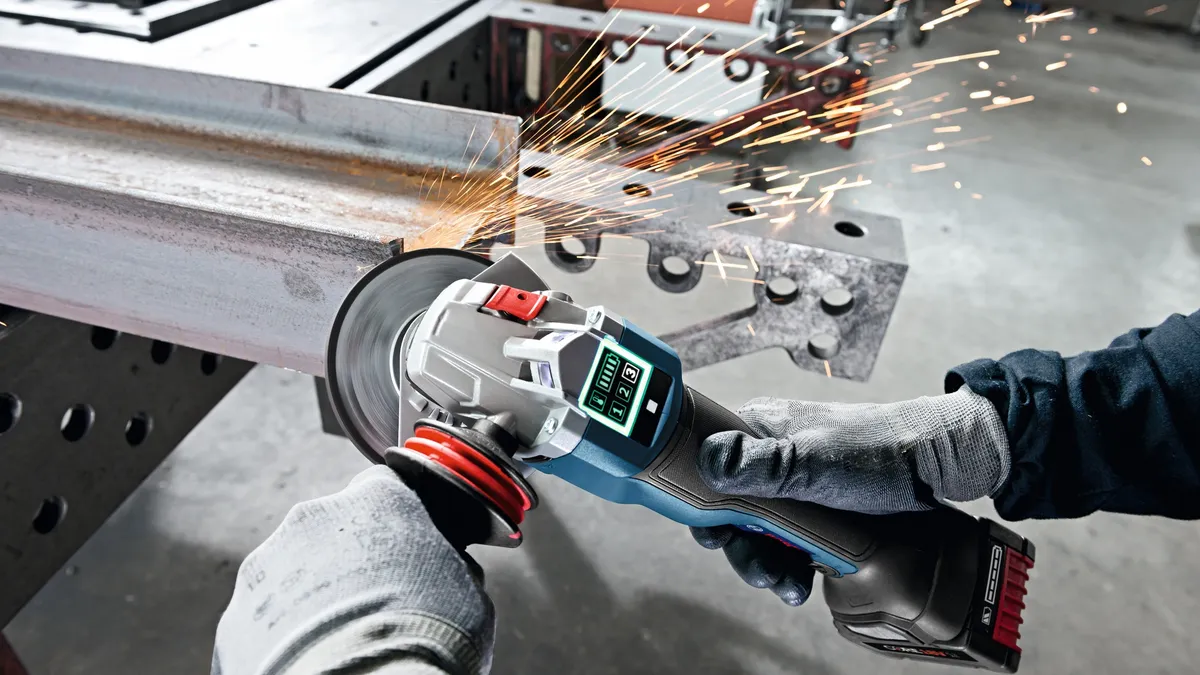Construction has a certain reputation when it comes to productivity. In fact, according to McKinsey & Company, construction's efficiency standards lag well behind those of manufacturing, retail and other industries. While segment-wide advancements seems to be butting up against a wall, the research firm said that one way contractors and managers can break through the wall, one project at a time, is by better integrating and relying on automation and digitization technologies on the jobsite.
That’s where the growing availability of smart jobsite tools and equipment are coming into play. Bosch Power Tools, for example, recently launched a line of Bluetooth-connected tools that includes cordless drills, an angle grinder and a lamp, all customizable via an app.
Product manager Michael Iezzi said workers can set the drills' precision clutch and kickback control sensitivity function remotely via its Toolbox app, and can turn the cordless lamp on with their smartphones prior to their arrival on the jobsite, making for a safer entry and a ready-for-work space. The app also notifies users if the tools are overheating and about potential malfunctions, he said.
Likewise, construction project managers can use the app to identify where on the jobsite — within 100 feet — tools are being used, how they’re being used and, perhaps more importantly, if they’re being used at all. “Supervisors,” Iezzi said, “are very much interested in whether tools are running and where.”
Milwaukee Tool has a similar smart solution, called One-Key, that the company says allows users to track and monitor tool performance and productivity. The app is available with a line of compatible and customizable tools that include a compact impact wrench, hammer drill, ratchet, saw, crimpers, cable cutters and high-impact lighting.
Workers also can set custom, job-specific profiles for fasteners, materials, output speeds and power. Once the profile is completed and saved, it’s stored in the tool, so a connection to the smartphone app is no longer necessary.
Christian Coulis, Milwaukee Tool's vice president of project management for One-Key, said one of the company's contractor customers has increased efficiency and saved money with the system’s preset tool functions, which, among other things, keep users from over-tightening fasteners during the installation of solar panels, thereby avoiding damage to the panels.
More than just smart tools
The quest for increased jobsite productivity doesn’t stop with handheld tools and lighting. Komatsu America, for example, has outfitted lines of bulldozers and excavators with intelligent machine control to help maximize every move.
In 2013, Komatsu introduced what it claims was the world’s first machine-control dozer with fully automatic blade control. The dozer has built-in, automatic blade control that receives real-time data from an integrated GPS platform and moves the blade according to 3D, computer-aided drawings and by coordinates generated from design drawings. Komatsu said the dozer, on its own, can complete work according to plans and specifications; all the operator has to do is move the machine toward the targeted work area, which is displayed on a monitor.
Sebastian Witkowski, product marketing manager for the company’s intelligent machine controls, said Komatsu continues to improve its equipment performance with advances in automation logic and GPS. He said users report a reduction in project schedules of up to 63% when compared with conventional construction methods.
Reasons for lack of widespread adoption
Even with such benefits, not all contractors have embraced smart jobsite tools and equipment. Coulis said this can be boiled down to three reasons:
- Technology is evolving at such a frenetic pace that it can be overwhelming for those who have to ascertain what will be the most valuable tools to adopt.
- Construction industry decision makers are often busy running their businesses and don’t have a lot of time to research what smart tools or equipment might benefit their operations.
- It’s a matter of company culture, particularly in midsize to large corporations where there are many individuals, from tradesmen to executives, who all need to get behind a major technology shift. “Tech needs to deploy for a reason,” he said.
Witkowski noted that there is hesitancy on the part of some contractors for taking on such powerful technology. “As with any new advancement, there is concern that machine control and (GPS) positioning on the jobsite will be complicated and difficult to learn,” he said. “This erroneous train of thought is the largest barrier that prevents contractors from benefiting from this technology today.”
Coulis said this is why Milwaukee takes painstaking efforts in the course of beta and field testing, as well as design validation, to make sure the product makes sense for the contractor and works seamlessly, even down to such details as button placement.
Once contractors have these smart tools and devise their own customizations, Iezzi said, that’s when the benefits become clearer. He said he expects the most powerful mechanism for wider adoption of connected tools will be the domino effect, with users handing them to each other and creating demand. “It’s just igniting right now,” he said.
Iezzi said it shouldn’t take long for craftsmen to adapt. “The basics really haven’t changed,” he said. “Hand tools have become power tools and now they’re connected. At the end of the day, they just want to use their angle grinder.”





















